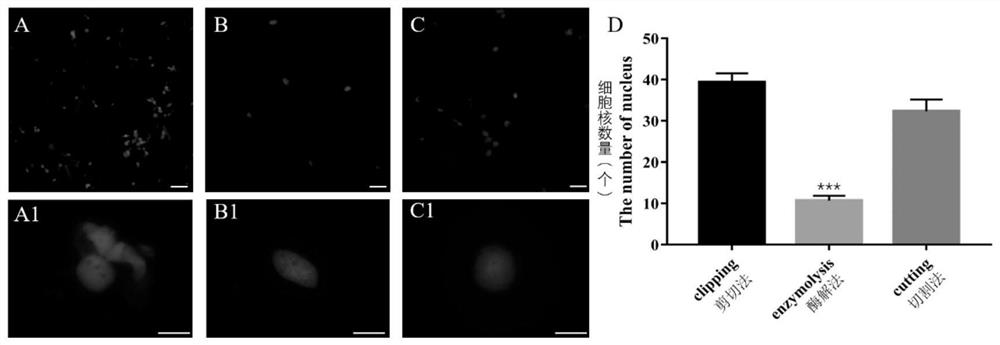A Method for Extracting Nuclei from Wheat Roots Suitable for Immunofluorescence Analysis
A technology of immunofluorescence and extraction method, which is applied in the field of cell biology, can solve the problems of not being suitable for wheat crops, etc., and achieve the effect of good staining effect, maintaining activity and increasing efficiency
- Summary
- Abstract
- Description
- Claims
- Application Information
AI Technical Summary
Problems solved by technology
Method used
Image
Examples
Embodiment 1
[0038] A method for extracting cell nuclei from wheat roots suitable for immunofluorescence analysis, the steps of which are:
[0039] (1) Obtaining of young wheat roots:
[0040] The experimental material is the wheat variety (Triticum aestivum L.) Huamai No. 8. After the seeds are disinfected and washed, they are placed in a petri dish with moist filter paper to germinate in the dark (20-25°C), and the seedlings are moved to the culture room for growth after 1 day of germination. During the growth period, the nutrient solution was replenished twice. After the seedlings grew to the fifth day, the wheat radicles were taken for the cell nucleus extraction experiment. The cultivation conditions of the seedlings in the cultivation room: 18-23°C, 65-75% relative humidity, 12 hours of light -14h / d.
[0041] Described nutrient solution is 1 / 2 Hoagland's nutrient solution, and its formula is: 2mM calcium nitrate (Ca(NO 3 ) 2 ), 2.5mM potassium nitrate (KNO 3 ), 0.5mM ammonium nit...
Embodiment 2
[0061] Optimization and Improvement of Nuclei Filter Method
[0062] The method of cell nucleus filtration is a key experiment in the preparation process of cell nucleus suspension. The improvement and optimization of the extraction method of wheat root nucleus in this experiment is mainly aimed at the improvement of the complicated and inconvenient cell nucleus filtration method in the past. First of all, the filter equipment consists of the cell mesh screen ( figure 1 A) Replaced by a simple homemade filter ( figure 1 C), the required material is a 450 mesh nylon membrane and a sterilized 1.5ml centrifuge tube ( figure 1 B) After cutting the nylon membrane into a disc with a diameter of 2cm, fold it into a hole shape and put it into the centrifuge tube. The three-layer filter membrane is close to the tube wall ( figure 1 C).
[0063] Compared with the extraction of plant tissue nuclei, the current existing cell filter screens are relatively large in size and cannot be...
Embodiment 3
[0066] Comparison of Three Different Extraction Methods for Extracting Nuclei from Wheat Young Roots
[0067] The results of extracting wheat radicle nuclei by different methods are as follows: figure 2 shown. It can be seen from the figure that there are many impurities on the cell nucleus glass slide prepared by the shearing method, and it is difficult to distinguish cell fragments from the nucleus ( figure 2 A). In addition, some cell nuclei are incomplete in shape, and the nuclei are mostly in clusters, which are difficult to separate when they stick together ( figure 2 A1). However, the number of nuclei in the nucleus suspension obtained by the shearing method was the largest ( figure 2 D).
[0068] The preparation of cell nucleus suspension by enzymatic hydrolysis takes a long period of time, and it is not suitable to ensure the activity of cell nucleus. Moreover, the method extracts the least number of nuclei ( figure 2 D). However, the nuclei prepared by this m...
PUM
| Property | Measurement | Unit |
|---|---|---|
| diameter | aaaaa | aaaaa |
Abstract
Description
Claims
Application Information
 Login to View More
Login to View More - R&D
- Intellectual Property
- Life Sciences
- Materials
- Tech Scout
- Unparalleled Data Quality
- Higher Quality Content
- 60% Fewer Hallucinations
Browse by: Latest US Patents, China's latest patents, Technical Efficacy Thesaurus, Application Domain, Technology Topic, Popular Technical Reports.
© 2025 PatSnap. All rights reserved.Legal|Privacy policy|Modern Slavery Act Transparency Statement|Sitemap|About US| Contact US: help@patsnap.com



